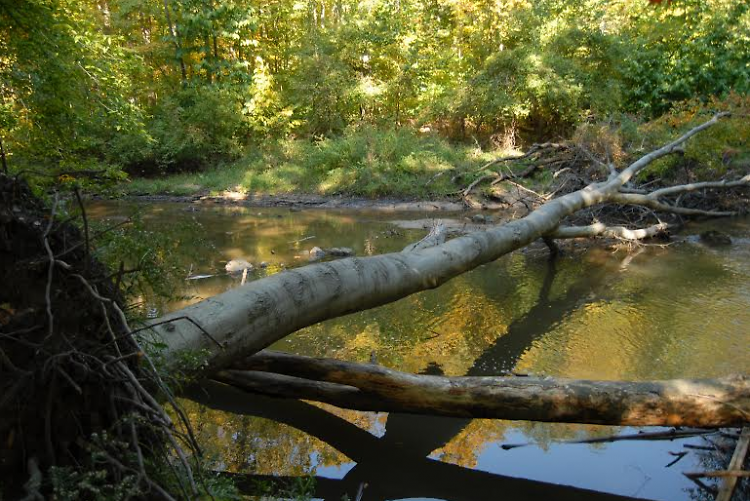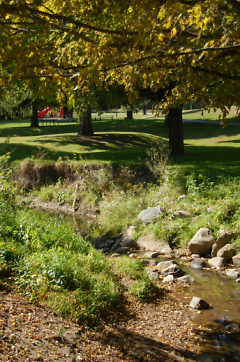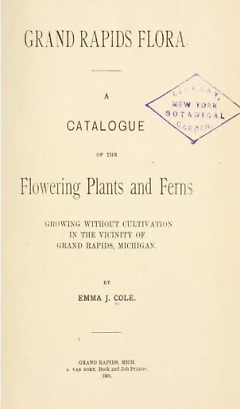Written by Michael Ryskamp and Gail Heffner with research assistance by Kelsey Waterman and Owen Selles
In 1901, botanist Emma Cole published "Grand Rapids Flora," an ambitious endeavor representing years of tromping through natural areas in and around Grand Rapids, hundreds of square miles surveyed, and over 1,200 plants catalogued.
The picture of Grand Rapids painted in the pages of her flora often stands in stark contrast to the city in which we live today. Specifically, her documentation of the Plaster Creek watershed has given us a representation of the ecosystems that once thrived where industrial parks now lie abandoned and crumbling. Her habitat descriptions and plant identifications detail a wet, sandy prairie habitat above the “oakdales” of Silver Creek, and we learn from her surveying that a now extinct population of Prairie Smoke once grew in the hills above Plaster Creek, a threatened species that has only been identified in six other counties in Michigan.
But it’s clear that even by 1901 Emma Cole was giving us a snapshot of a landscape greatly altered by clear-cut timber harvesting and gypsum mining. The creek, originally named by Native Americans as “Kee-no-shay” meaning “water of the walleye,” had already been renamed by European settlers for the gypsum mined from its bedrock and the plaster milled along its bank. The gypsum quarries and plaster mills greatly polluted the waterway, leading to the demise of the walleye population in the stream. In 1910, just a few years after Cole’s publication, a prominent Grand Rapids leader, Charles Garfield, addressed the State Horticultural Society and lamented the death of Plaster Creek:
"We came to Michigan when I was 10 years old, and a little way from my home was Plaster Creek…That stream was my playground during the next six or eight years…my companions [and I knew] the individuality of a great many trees; we knew the kinds of fish that made their home in that creek. We even had a boat and paddled up the stream for miles and enjoyed each summer the beauties of that most delightful natural playground. [The stream] that gave me this joy...is now a most fitful affair… The playground is gone. Where there was one child then to enjoy that playground there are now eight thousand children who ought to have a playground like this, but a near sighted utilitarianism has snatched it away. We have stolen their rightful heritage from them, and when you [the State Horticultural Society] are discussing so splendidly today the methods of getting a living…and securing a competence for old age, I would have you think for a moment at what a sacrifice some of us are acquiring...what betterments through our labor ...while we are forgetful of the children’s playgrounds and the children’s rights of play," said Garfield.
The problems facing Plaster Creek have only grown in severity and complexity since Garfield’s time. For many of us, this is simply the story of Plaster Creek as long as we have known it. We’ve not understood its problems or, more commonly, the problems of Plaster Creek have been invisible to the majority of us.
We cannot lament what we don’t know. And many don’t understand the loss of what was once a resource and is now a liability for our community. Today, stormwater creates unnatural surges in water levels, bringing the stream above its banks and then receding to reveal a hazardous, eroding channel; concentrations of E. coli bacteria from unknown sources make the stream unfit for almost any type of recreation and toxic metals from old industries pose a contamination threat.
Living into the future...with hope
To increase the public’s awareness of water pollution, we are launching educational efforts throughout the watershed. A Michigan State designed survey, used across the Great Lakes region, has been sent out to many watershed residents living in Caledonia, Gaines and Ada, to measure the public’s knowledge of critical issues facing the headwaters of Plaster Creek. It also measures people’s awareness of household practices that can help restore the creek’s beauty and quality. If you were randomly selected and received a survey in the mail regarding the Plaster Creek watershed, please take a few minutes to answer the questions. By carefully monitoring the data from these surveys, we can target our educational programs and understand the impacts of our work on the perceptions and attitudes of people who live in the watershed.
An effective restoration effort in the Plaster Creek Watershed will require more than just addressing the environmental conditions- cleaning up trash, removing invasive species, and stabilizing public stream banks- it will require a shift in our community’s perception of the natural world and a fundamental change in the way we interact with the ecosystems in which we live.
It could take many years, maybe even decades, to clean up the watershed. But if our efforts are backed by a community of citizens aware of the watershed’s problems, and prepared to change their behaviors, there is still hope to see the health and beauty of Plaster Creek restored- maybe even enough to change its name back to ‘Kee-no-shay.’
The Rapidian, a program of the 501(c)3 nonprofit Community Media Center, relies on the community’s support to help cover the cost of training reporters and publishing content.
We need your help.
If each of our readers and content creators who values this community platform help support its creation and maintenance, The Rapidian can continue to educate and facilitate a conversation around issues for years to come.
Please support The Rapidian and make a contribution today.



